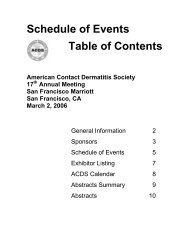American Contact Dermatitis Society 21 Annual Meeting
American Contact Dermatitis Society 21 Annual Meeting
American Contact Dermatitis Society 21 Annual Meeting
You also want an ePaper? Increase the reach of your titles
YUMPU automatically turns print PDFs into web optimized ePapers that Google loves.
General Session / Fisher Presentations<br />
Systemic Hypersensitivity to an Implantable Cardioverter Defibrillator wth<br />
Positive Patch Test Results Without Cutaneous Manifestations<br />
Israel Andrews, Pamela Scheinman, Department of Dermatology, Tufts Medical Center, Boston MA<br />
Objective: To present a case of systemic hypersensitivity to components of an implantable cardioverter<br />
defibrillator (ICD). Our patient showed relevant patch test reactions to materials in the ICD, without<br />
accompanying dermatitis.<br />
Results: A 51-year-old woman status-post implantation of an ICD developed hypotension, vomiting,<br />
rigors and fever post operatively. Her symptoms persisted until the ICD was removed 3 weeks later. An<br />
extensive work-up for infection was negative. She had no dermatitis during this time.<br />
Patch testing was performed to a Tufts Medical Center standard, metal, epoxy, isocyanate, and rubber<br />
series. Patches were removed and read after 48 and 72 hours. Among her relevant reactions included 3+<br />
cobalt chloride, 1+ nickel sulfate, 3+methylenedianiline (MDA), 2+ p-phenylendiamine (PPD), and 1+<br />
toluenediisocyanate (TDI). Cobalt and nickel were present in the ICD per the manufacturer. They would<br />
not confirm whether materials cross reacting with PPD, MDA or TDI were present in the coating of the<br />
ICD.<br />
Conclusions: This is the first report of systemic hypersensitivity to proven contact allergens within an ICD.<br />
Our patient had no dermatitis but rather sepsis-like symptoms. Patch testing defined allergens within her<br />
ICD and guided the preparation of a custom-made ICD, which she tolerated without sequelae. Once<br />
infection is ruled out, patch testing should be considered in the work-up of unexplained symptoms after<br />
ICD placement, even in the absence of dermatitis.<br />
Allergic <strong>Contact</strong> <strong>Dermatitis</strong> Following Postsurgical Closure with Dermabond®<br />
Casey Bowen, M.D. 1<br />
Jeffrey Bidinger, M.D. 2<br />
Chad Hivnor, M.D. 2<br />
J. Scott Henning, D.O. 2<br />
Aaron Hoover, M.D. 2<br />
1 Little Rock Air Force Base, Arkansas<br />
2 Wilford Hall Medical Center, San Antonio, Texas<br />
We report three cases of surgical wounds complicated by allergic contact dermatitis (ACD) to<br />
Dermabond®. Allergic contact dermatitis was confirmed by use test in all three patients. 2-<br />
octylcyanoacrylate topical skin adhesive (Dermabond®; Ethicon Inc, Somerville, New Jersey) was FDAapproved<br />
for use as tissue adhesive in 1998. Despite extensive use, there have been relatively few<br />
reported cases of ACD associated with its use. The increased popularity of Dermabond® in emergency<br />
rooms, clinics, and operating rooms, could lead to an increased prevalence of associated ACD.<br />
Cyanoacrylates are widely employed as adhesives ranging from household products to nail and beauty<br />
salons, and even dentistry. We will discuss the recognition and management of ACD to Dermabond®<br />
with the goal of minimizing poor surgical outcome.<br />
17






